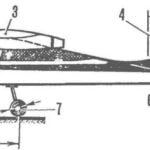 Music lovers understand the interest shown by people of different ages and professions to all new in the field of stereophony. The development of electronics and improvement on the basis of sound engineering techniques have enabled the lovers of house concerts to listen to gramophone records and tape recordings with a sound quality close to natural. Stereo replay system allows to obtain aesthetically the most complete and accurate representation of the executable composition, all the colors, the nuances that are sought to convey in a recording musicians.
Music lovers understand the interest shown by people of different ages and professions to all new in the field of stereophony. The development of electronics and improvement on the basis of sound engineering techniques have enabled the lovers of house concerts to listen to gramophone records and tape recordings with a sound quality close to natural. Stereo replay system allows to obtain aesthetically the most complete and accurate representation of the executable composition, all the colors, the nuances that are sought to convey in a recording musicians.
To obtain high-quality stereo playback, the novice designer-lover it is necessary to study the nature of the stereo effect: only then can we create a listening environment in which this effect is manifested clearly.
The source of the “bulk” of the program can serve as a stereophonic record player, tape recorder or radio. A detailed discussion about the principles, structures and special features of this instrument we shall in the following sections of the rubric.
Meantime, remember that the main difference between any stereo device from mono is that it is designed for simultaneous playback of two sound signals forming a stereo pair. These signals must be different from each other as well as the sounds that impacted the microphone when recording. Needless to say that the stereo reproducing apparatus should contain two identical transmission channel: two amplifiers and speakers. Latest set from each other at a distance of two and a half to three meters, based on specific conditions: the size of the room, its acoustics, arrangement of furniture, etc.
How better to choose a place for sound speakers? Where to stay the most to benefit from stereo sound manifested itself most clearly? And finally, what are the requirements for technical performance of the equipment?
These questions are easy to answer, to understand the essence of stereo.
As already mentioned, the stereophonic reproduction differs from the common mono more natural. When you transfer stored spatial sound perspective: the listener perceives location of the instruments of the orchestra and soloists. This feeling separate location of sound sources in space is called localization of sound images. Localization — the new sound quality inherent in only stereo playback.
When recording sound with a special arrangement of microphones in the Studio and adjusting the incoming signals to the remote sound engineering to ensure that certain instruments of the orchestra were heard from the left speaker, others from the right. Sound sources, distributed Director in both channels will be heard from both speakers simultaneously, the listener would think that these instruments sound between the speakers in the center, forming a kind of apparent sound source.
This purely psychological effect of the merger sound image when emitting the same sound of the two loudspeakers is the most interesting feature of the human ear. If the volume of the sound one of the speakers increase, the listener will feel as if the movement of the sound source from the midpoint of the base in the direction of a more “loud” speaker.
It is easy to understand that, spreading when recording individual instruments of the ensemble and the soloists between the two stereo channels in the desired ratios, it is possible to achieve uniform distribution throughout the base from the left to the right column, providing, thus, the correct stereo balance.
There is another peculiarity of human hearing, which has to be taken into account in stereophony.
Above we said that if two speakers emit the same sound at the same volume, the sound image seems located in the center of the base. But really quite small, only thousandths of a second, the delay of arrival of sound from one speaker to produce a so-called “effect of precession”. It consists in the fact that the listener begins to perceive only the leading sound, ceasing to note the work of the backward dynamics.
While obviously acceptable to the sounds of the instruments, which, for example, LETI side of the orchestra, influenced not only the microphone but also to the far set right. The sounds of the “left” of instruments come to the right microphone later than to the left. Thereby creating the effect of “left” localization of this instrument when playing.
Thus, the localization in stereophony can be caused by gramotnymi or time differences between the incoming to the listener sound signals. This circumstance must be taken into account for the correct selection of the listening position for stereo programs.
The spatial distribution of the individual instruments .their precise localization make the overall sound of the orchestra legible, clear timbre of the instruments perceived to be “clean”, and, as specialists, engineers, improving “transparency” of the sound.
And another important feature stereo playback: it more accurately represents the acoustic atmosphere of the hall or Studio where performed a piece of music. This is because the direct sounds, i.e. who came to the microphones directly from the artists, “mixed” and the sounds reflected from the walls and ceiling of the hall. This so-called “diffuse”, diffuse the sounds entering the microphone with different time delays, are perceived by the listener as “blurred” in space surround echo.
Arising from this feeling a “presence effect” — many listeners is regarded as the most impressive feature of stereophony.
To obtain a stereo image reproducing apparatus for special requirements. First of all both stereo channel — amplifiers and loudspeakers— should be almost identical.
Indeed, since the localization of individual instruments of the orchestra depends on the ratio of the volume of the sound from the right nd left speaker in the first place should be strictly the same coefficients of transmission of the two channels, that is, strengthening each of them.
The identical should be and speakers: from signals of the same level, they must have the same volume.

The predominance of volume one of the speakers will result in a displacement of the entire sound to a more “loud” dynamics, violate intended by the sound engineer when recording a soundscape.
Equal amplification of both channels must be maintained at all frequencies of the audio range. In other words, the selection or the design of stereo equipment are required to present the stringent requirements not only to frequency characteristics of each of the channels separately (the same rules as for high quality monophonic instruments), but the exact coincidence of the frequency characteristics of the channels forming a stereo pair.
If you build a bath or sauna, wooden wall panelling Lipa will interest you.
The discrepancy between the gain channels on the individual frequencies of the audible range can lead to arbitrary movement of the individual instruments on the basis of the transitions from one music to another, from one register to another.
We should not forget about the phrasing of the channels of a stereo pair. From the phase relations in the left and right signals depends on the sense of merging sound image, clarity of localization.
If sound waves emitted from speakers are out of phase, the sound images become “wandering”.
B. MEERSON, engineer



